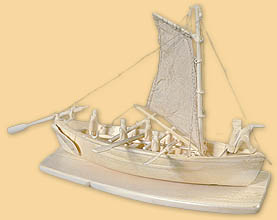 |
George M. Curleigh joined the RCMP in 1920 and was stationed in
Pangnirtung on Baffin Island between 1926 and 1928. Later he became
the commander of the detachment for the Western Arctic in Aklavik.
It appears that he retired to New Brunswick. RCMP records state that
he died in 1985.
In 1973, he sold the collection which he had acquired during his
stay in Pangnirtung to the CMC. In his accompanying letter, he remembers
the conditions under which he acquired these items. He would either
obtain them by barter during the routine patrols, or Inuit from
surrounding camps would bring them to the RCMP detachment
in Pangnirtung.*
* CMC Archives (collectors' files)

 |
Model Whaleboat, 1926-1928
Area around Pangnirtung, Nunavut
Ivory, cloth, string
4 x 21 x 6 cm (boat)
CMC IV-C-5180
Collected by George Curleigh while stationed at the Pangnirtung RCMP
detachment between 1926 and 1928
|
 |
Curleigh identified the artist as Ataguja. Memories of the
whaling era persist and are often reflected in the art from
Pangnirtung even today. The exact replication of the rigging shows
exquisite craftsmanship and the maker's familiarity with the original.
Two of the men wear beards and moustaches, possibly to identify
them as Europeans.
Exhibition History:
Aboriginal Economy. First Peoples Hall. Canadian Museum of
Civilization, Zone 4, February 5, 2001 until the present.
Arctic Mirror. Canadian Museum of Civilization, Hull, Quebec,
January 25 – September 9, 1990. No catalogue.
Harpooned Bowhead Whale, 1926–1928
Area around Pangnirtung, Nunavut
Ivory
5.5 x 29.5 x 6 cm
CMC IV-C-5177
Collected by George Curleigh while stationed at the Pangnirtung RCMP
detachment between 1926 and 1928
|
 |
Unusually large for any carving in the historic era, this whale may
be part of the whaling boat, also in Curleigh's collection (IV-C-5180).
Its maker had more the sensibilities of a sculptor, than of a miniaturist.
The body of the massive animal is elegantly sculpted, with emphasis
on its giant form rather than on fine details.
Komatik with Three Dogs, 1926–1928
Area around Pangnirtung, Nunavut
Ivory, sealskin, wood
Sled: 3 x 29 x 7 cm
Dog-a: 4 x 7 x 1.5 cm; dog-b: 3.5 x 6 x 3 cm ;
dog-c: 1.7 x 5.5 x 1.2 cm
CMC 1973-051-009
Collected by George Curleigh while stationed at the Pangnirtung RCMP
detachment between 1926 and 1928
|
 |
The handsome sled shows the same assurance and skill as the whaling
boat, the kayak and the harpooned whale from Curleigh's collection.
There is a good chance that all are by the same maker who liked to
work on a larger scale. The dogs each have a different posture and
facial expression.
Model of a Kayak, 1928–1928
Area around Pangnirtung, Nunavut
Ivory
7 x 37 x 4.5 cm
CMC IV-C-5175
Collected by George Curleigh while stationed at the Pangnirtung RCMP
detachment between 1926 and 1928
|
 |
The Inuit tradition of making models preceded the arrival of
strangers in the North. "Death is not considered by the Eskimo
as the end of existence, but merely as a break in one's life. For
this reason articles which will be useful are placed on the graves of
the deceased."* A kayak such as this would certainly have been
considered necessary and useful for life after death.
*E. W. Hawkes
1916 – The Labrador Eskimo. Ottawa: Government Printing
Bureau, (Geological Survey of Canada) Memoir 91; Anthropological
Series, No. 14, p. 136.
|